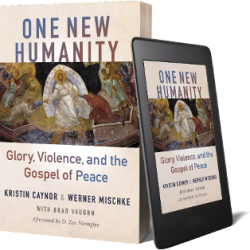One reason why people reject the gospel is simply this––they don’t get it. Maybe it’s not a coincidence that many Christians don’t read their Bible for a similar reason––they don’t get it.
How do we make the Biblical message simple enough that anyone can understand it?
Honestly, there’s a problem with that question. On the one hand, the answer is blatantly obvious––we can’t. The Bible talks about an infinite God. How could we ever expect anyone to get our minds around our great God? On the other hand, there is plenty that can be understood even by children.
Simply Confusing?
We need to reconsider what we mean by “simple.”
Ironically, the attempt to keep gospel presentations “simple” might be the reason that people find them so confusing, if not incoherent or irrelevant. Many gospel tracts consist of . . .
Selective Systematic Statements
Since we can’t say everything, we have to be selective. Yet, how are we to choose one set of ideas over others? Practically, tracts tend to reflect traditional emphases rather than the Bible.
In order to make sense, tracts give systematic presentations. In the process, they can feel fragmented. When tracts mainly consist of a set of doctrinal statements, the gospel become too abstract and philosophical to be relevant to the lives of normal people.
Why I wrote The Creator King
Those who’ve written traditional tracts were well-intentioned. I am grateful for their efforts to preach the gospel. However, we must also be on guard not to let tradition usurp Scripture.
I wrote The Creator King because I simply saw no other tools that went far enough to improve upon the limitations of typical presentations. I hope both this presentation and The Promises of God will better equip the Church to preach the gospel in a way that is biblically faithful and culturally meaningful.
The Creator King tells a . . . .
Single Scriptural Story
The Bible is not primarily a compilation of smaller stories that teach a collection of spiritual principles. In fact, the Bible narrates a single narrative in which God is the central character. The entire presentation reflects the unity of Scripture itself, focusing on God’s mission to bring about his kingdom in the world.
We desire to preach the gospel in a manner that is more comprehensive and coherent. Our gospel presentations can better reflect the biblical text within a particular cultural context.
Making a convert is not the same thing as making a disciple. The latter is much harder. In truth, the gospel is a call to discipleship, not merely conversion. Accordingly, our gospel presentation should reflect that fact.
One Story, Six Stages
The Creator King tells the grand Story in 6 stages, a few which tend to be overlooked in most presentations. It was originally designed for a Chinese context, so some of the following section titles may not reflect natural English titles.
In each part, I include a few questions to spur reflection and conversation. In addition, I list a number of passages that direct readers’ attention back to Scripture.
1. One Family Under Heaven (天下一家)
This section introduces the one true God as the Creator King as well as his plan for the world.
2. Losing Face & Seeking Face (丢脸争面)
The world’s problem extends far beyond the Garden account. This section reflects the pervasive nature of sin in all aspects of life throughout history.
3. King of All Nations (万民之王)
Most of the Bible recounts the how God reveals himself to and through the people of Israel. Without Israel, the biblical gospel makes no sense. Now, I’m sure that some readers will think that my last sentence makes no sense. In the coming months I will unpack this point much more as I introduce my forthcoming book One Gospel for All Nations: A Practical Approach to Biblical Contextualization.
4. Setting the World Right (拨乱反正)
Of course, the gospel focuses on how God through Christ sets the world right. This section explains how Christ’s life, death, and resurrection fit within the overarching narrative of Scripture.
5. Honored through Shame (以辱为荣)
This section clarifies the gospel message by making clear its implications for our lives. The gospel overturns a person’s sense of honor and shame. To truly believe the gospel entails being a disciple with a transformed worldview.
6. Avenging Shame and Restoring God’s Kingdom (雪耻复国)
Finally, the gospel foretells the day when Christ will return and God’s glory will spread throughout the earth.
How Should We Respond?
The response section of The Creator King differs from other print presentations.
It does not have a formal “sinner’s prayer”, which often confuses people, causing people to think a prayer has some sort of spiritual power (as in Buddhism, etc.).
Instead, it first explains why this Story relates to individual readers. Then, the tract/booklet explains the change that comes with true faith. Ultimately, it transforms a person’s identity, including every part of his or her life––––head, heart, and hands.
Does a person discern a heart change such that he or she gives ultimate allegiance to Christ as King? Does he or she desire to follow Christ with their head, heart, and hands? When people see this new love emerge in their heart for Christ, they know belong to God’s kingdom family. This is gives far better assurance of true faith than the mere recitation of a prayer.
On the Resources page, you will find a full assortment of tools to assist you in using The Creator King. These include English and Chinese versions of
. . . the presentation
. . . “How to Use” guide
. . . two types of bookmarks
Print them off, put them on your phones, use them for small group studies . . . .
I look forward to hearing your feedback.
Photo credit: Credit: Creation Commons 2.0/Pinterest













